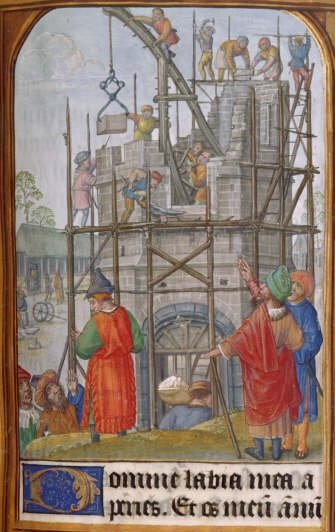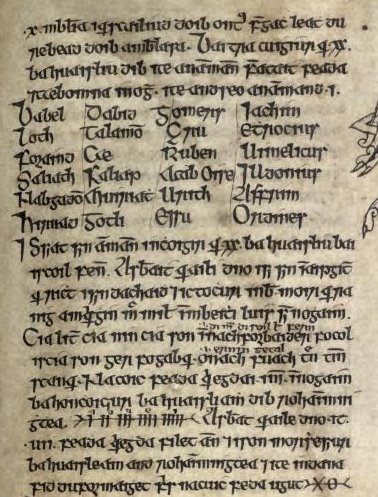BabelStone Blog
Saturday, 1 April 2006
The Legend of the Babel Stone
One question that I am frequently asked is why is my web site called BabelStone ?
The answer is that it is named after the famous (or rather, not-so famous) 14th century Babel Stone, on which there was supposed to be an inscription in the primordial language that was spoken before the Tower of Babel was built. I first read about it when I was at school, and was just becoming interested in ancient and obscure languages. For many years I have quietly harboured the hope that I may one day be able to solve its mystery, and so when I started up my web site on languages and scripts it seemed the obvious name to adopt.
The Babel Stone itself is now long lost, and there is very little primary material relating to it, so some scholars have simply dismissed it as a medieval forgery, if they have deigned to discuss it at all. Almost all our information about the stone comes from Samuel Johnson's 1722 history of Kentish inns and taverns (vol.I pp.218-220), where he quotes from a manorial court document from the manor of Broctone (modern Broughton) in Otford (or Otteford as it was then known). Otford is a picturesque Kent village on the river Darent, about 25 miles south-east of London, and was on the main pilgrims' route from London to Canterbury during the middle ages, but is unfortunately now spoiled by the network of motorways that surround it on all sides. The manuscript, which was dated the 5th of May in the 31st year of the reign of Edward III (1357), relates to a property dispute, and records that (at some unspecified time previously) a large stone had been dug up by a certain Thomas de Bedell during the construction or repair of the house in question, and that the stone was inscribed with strange writing that no-one could read. This stone was called the "Babel stone" because (or so Johnson says) the inscription was thought to be in the original language of Adam that anteceded the confusion of tongues when the Tower of Babel was built (Johnson suggests that it may have been in Hebrew, but that is probably based on 18th century ideas about the history of languages). Johnson also implies that he had seen a drawing of the inscription in some other source, but much to our great annoyance he does not reproduce the drawing or even name the source. The present location of the original manorial document is also unknown.
The Building of the Tower of Babel (circa 1500)

It is not known what happened to the Babel Stone after it had been discovered, and there appear to be almost no mention of it in local histories of the area. I had the theory that it would probably have been stood in a local churchyard or incorporated into the actual building of a church, in the same way that Ogham stones are sometimes moved from their original site into the precincts of a church (cf. the Ogham stone at St. Kew in Cornwall). Indeed, I spent most of the summer of 1982 combing the churches and churchyards of north-west Kent, but to no avail. I am now resigned to the fact that the stone must have been destroyed, and that our only hope of deciphering its mysterious inscription is if the sources referred to by Johnson ever come to light.
My own theory of why it is called the Babel Stone differs somewhat from that of Johnson. I believe that the inscription on the stone was in the ancient Ogham script that was used to carve brief memorial inscriptions in proto-Irish on stone slabs throughout Ireland during the Dark Ages. Ogham stones are also found in Scotland, the Isle of Man, Wales and Cornwall/Devon, but, with only one exception, they are restricted to the Celtic fringes of the British Isles. The only Ogham stone that has ever been discovered outside of these Celtic areas was found in 1893 at the bottom of a well belonging to a Roman villa in the Roman town of Silchester (Calleva Atrebatum) in Hampshire, not so very far from where I work.

What is suggestive to me is that the Silchester Ogham stone is associated with a Roman settlement (it is assumed the stone was erected by an Irish immigrant in late Roman times), and there are also many Roman villas in the viscinity of Otford, where the Babel Stone was discovered. It seems quite conceivable to me that Irish merchants would be attracted to settlements such as Silchester and Otford as Roman occupation of Britain crumbled, and that they would have brought with them their custom of commemorating the dead (or the living, no-one is quite sure) with Ogham stones.
A further intriguing connection with the Ogham script can be seen in the very name of the stone. Early Irish histories, such as the Auraicept na n-Éces ("the scholars' primer") in the Book of Ballymote, tell us that the Irish Gaelic language and the Ogham script both originate from the Tower of Babel. According to legend, the Scythian king, Fenius Farsa (or Fenius Farsaidh), visited the Tower of Babel shortly after its failure, only to find that that the builders of the tower had already dispersed. Fenius stayed at the tower, but sent out seventy-two scholars to study each of the seventy-two languages that were now spoken by the builders of the tower. After ten years the scholars returned, and Fenius took the best parts of each language in order to create a "selected language", which he named Goidelic after his companion Goídel mac Ethéoir. Fenius is also reputed to have discovered four writing systems, Hebrew, Greek, Latin and Ogham, and as Ogham was the most perfect of the four it was chosen for writing the Goidelic (i.e. Irish) language.
The Book of Ballymote (follow link to Royal Irish Academy)

The Ogham letters are here named B for Babel, L for Lot, etc.)
Thus Ogham was considered to be the script of Babel, and naturally enough a stone with Ogham writing on it would be called a "Babel stone". Perhaps in the 14th century knowledge of Ogham and the legend of its origins still persisted in the abbeys and priories of the region (the late Anglo-Saxon monk Byrhtferth of Ramsey was familiar with Ogham, and that was only a little more than three hundred years earlier).
The only problem with my theory is that Ogham is normally carved along the edges of a stone, and to the uninitiated eye the notches and strokes of the Ogham letters look nothing like a written script. However, Ogham is sometimes found carved on the face of a stone (this is the case with the Silchester stone), and if the inscription is complex enough it should have been recognisable as writing.
Addendum [2006-04-07]
Dave Robinson has kindly drawn my attention to The Kentish Polhills by R. G. Bennett, which is an unpublished genealogical study that was presented to the Otford & District Historical Society in 1958. The section on Broughton Manor includes the following corroborative evidence relating to the Babel stone :
Between 1354 and 1359 [William Kerl] obtained possession of several other Otford Properties, including a croft named Babelstone, and in 1360 he secured from Richard Brewere a meadow adjacent to the garden of the tenement of Broctone.
I think that this Babelstone croft must be the property where the Babel stone was reputed to have been found. The date ties in perfectly with the manorial document of 1357, at which time the ownership of the property was under dispute. Perhaps William Kerl not only gained possession of the property but also the mysterious stone. Is it too much to hope that he may also hold the key to the final resting place of the Babel stone ?
Addendum [2007-01-02]
I am very excited to announce that I have just recieved an email from an archaeologist doing research on the remains of a Roman building that has been discovered at a site called Church Field on Bubblestone Road in Otford. It is believed that the name "Bubblestone" is a corruption of the medieval "Babelstone". Evidence of wall plaster with Christian symbols suggests that the building was a Roman Christian building, and it is thought that the building was standing up until the medieval period, when it was demolished to make way for Otford Palace sometime during the 13th-15th centuries. The date of demolition of the building ties in with the earliest recorded record of the "Babel Stone" (circa 1360), and so it is reasonable to conjecture that the stone was salvaged from the Roman villa during the 14th century.
This new discovery even more than ever makes me think that the mysterious Babel Stone must have been an Ogham monument, and it really would be marvellous to be able to prove that the origins of this medieval stone lie in a Roman Christian building -- the Christian association with an Ogham stone is particularly intriguing, but perhaps not unexpected given the early introduction of Christianity into Ireland.
Excavation on the Bubblestone site is hoped to start soon, and I will keep this post updated with the details of any discoveries.
Archaeology | Inscribed Stones
Index of BabelStone Blog Posts